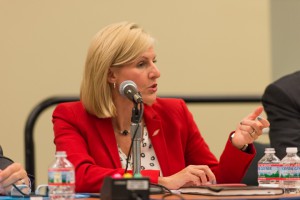Last month, the Alliance to Save Energy once again hosted a high-wattage gathering of energy efficiency experts from around the world. Now in its eighth year, Energy Efficiency Global Forum (EE Global) brought together policymakers, industry leaders, and members of academia to share their latest insights and “best practices” in saving energy.
Building Energy Efficiency in the Spotlight
Energy efficiency in homes and buildings was a popular topic, and for good reason: Buildings use 71% of America’s electricity, 54% of our natural gas, and 42% of all energy, according to the Energy Efficient Codes Coalition (EECC), and account for roughly 40% of U.S. energy consumption – more than industry or transportation.
Unfortunately, a lack of transparency around building energy performance remains a stubborn challenge, a number of speakers said. Measuring and disclosing buildings’ energy use could stimulate market demand for energy efficiency and encourage building owners to make energy improvements, but it is vastly underused.
Alliance President Kateri Callahan had good news. She announced the availability of a tool that will help quantify the benefits of building energy efficiency. With the new calculator, state air quality officers can gauge the carbon emission savings from state adoption and enforcement of the most recent building energy codes.
Jane Palmieri, Business President of Building and Construction at The Dow Chemical Company and newly elected Industry Co-Chair at the Alliance, explained that using energy-saving materials and solutions for new construction is vital: Get the building envelope right the first time. She said the average home contains a half-mile of cracks, and sealing them could cut energy bills by 20-30%. A lack of consumer awareness is another challenge. Energy efficiency often gets lost in the maze of choices home buyers face. A focus on immediate expenses may mean that they overlook ongoing energy costs. Ultimately, success in improving building energy efficiency will depend on awareness, appraisal (i.e., having energy performance listed on the appraisal form), and code enforcement.
Greg Merritt of Cree Inc., a lighting products company, reported that many states are woefully behind in implementing energy building codes. He called for more benchmarking so that energy savings factor into a home purchase: “You can’t make a good decision based on something you don’t understand.”
Policies Should Help Drive Energy Efficiency Improvement
Senator Jeanne Shaheen (D-N.H.), dubbed the “first lady of energy efficiency,” proclaimed that without energy efficiency, our nation would have used 60% more energy since 1973. But there is more to do, and she renewed her call for action on the bipartisan “Energy Savings and Industrial Competitiveness (ESIC) Act” (S. 720). Co-sponsored by Senator Rob Portman (R-Ohio), the bill contains sensible ways to improve energy efficiency across the economy. ACC is a longtime supporter. A targeted bill, the “Energy Efficiency Improvement Act of 2015,” passed the Senate and House and was signed into law on April 30.
In a rousing speech, Senator Chris Coons (D-Del.) called energy efficiency the “great test bed of bipartisanship.” He was feeling optimistic about moves by Congressional Leadership to solicit ideas for bills that could pass: “It’s a hugely hopeful sign.” He would like to see ESIC’s energy efficiency provisions move on their own.
Kevin Kolevar, Dow’s Vice President of Government Affairs and Public Policy, spoke at the morning plenary session on Wednesday. He said progress in energy efficiency requires a strong partnership between regulators and industry. In fact, “regulation done right can drive innovation.”
Industrial Energy Efficiency: Building a Better Plant
Ross Eisenberg, Vice President of Energy and Resources Policy at the National Association of Manufacturers, moderated a fascinating panel on “the advanced manufacturing plant of the future.” Mark Johnson, Director of the Advanced Manufacturing Office at the U.S. Department of Energy (DOE), underscored the reversal from outsourcing to in-sourcing underway among many manufacturers, largely due to the “unleashing of energy resources in the United States.” DOE has a “Better Plants Program” that supports the implementation of cost-effective energy efficiency improvements. A number of ACC member companies participate.
Andreas Schierenbeck, CEO of ThyssenKrupp Elevator AG, said transparency around energy use helps engage employers and get them competing with each other. In the chemical industry, the Responsible Care® Energy Efficiency Awards program is a great way for companies to share and be recognized for their individual progress. Since 1974, the U.S. chemical industry as a whole has improved its energy efficiency by 49 percent.
Learn more about the ways chemistry is creating solutions to improve energy efficiency:








